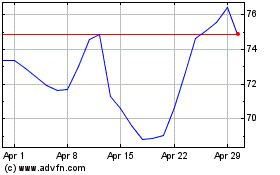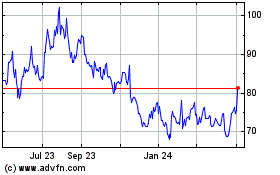By Jaewon Kang
Kroger Co. has spent years -- and hundreds of millions of
dollars -- investing in technology to give it a digital edge in the
grocery business. But when the coronavirus changed customers'
buying habits overnight, the grocery chain wasn't as ready for the
online shift as some of its competitors.
The nation's biggest grocer, Kroger has poured money into
projects ranging from a self-driving grocery delivery robot to a
partnership to sell goods in China through Alibaba Group Holding
Ltd. It also bet that a delivery model using remote fulfillment
centers, popular in Europe, would resonate stateside. Yet, when the
pandemic sent a tsunami of customers ordering groceries online for
the first time, it was unable to meet higher demand.
The wide-ranging investments slowed adoption of technology for
grocery delivery, leaving Kroger behind some of its competitors,
said former executives, current employees and a vendor.
A Kroger spokeswoman said the technology investments and
partnerships were timely and allowed the grocer to quickly expand
e-commerce services.
In response to the pandemic, Kroger has expanded contact-free
payments and introduced contact-free delivery and low-contact
pickup. It is also testing a subscription program that provides a
year of delivery for an annual fee of $79, she said.
Kroger has notched higher sales as customers have cooked more at
home. During its first quarter ended May 23, same-store sales
excluding fuel were up 19% from a year earlier, while profit jumped
57% and digital sales nearly doubled. But other chains have posted
bigger gains. Albertsons Cos. said same-store sales rose 27% and
digital sales nearly quadrupled in its quarter ended June 20.
Target Corp.'s same-store sales jumped 24% and digital sales nearly
tripled for its quarter ended Aug. 1.
Analysts expect Kroger's second-quarter results, scheduled for
Friday, to show same-store sales excluding fuel up 10.5%. Kroger
and other companies have said many customers' grocery purchases
continue to exceed the previous norm as they remain mostly at home
and work remotely.
Online demand has at times swamped Kroger and other grocers,
despite their steps to enable more delivery and online orders.
Retailers including Kroger added time slots for pickup or delivery,
hired employees to handle online orders and relied more on
Instacart Inc. to take and fulfill grocery-delivery orders.
Jeannie Wood, 60 years old, said she prefers in-person shopping
at her local Houston Kroger because she finds Kroger's mobile app
"clunky"; for example, she said, it doesn't always offer
substitutes for out-of-stock items.
"It gets frustrating," she said.
To smooth the way for digital customers, Kroger eliminated
service fees for pickup and introduced a mobile feature that allows
shoppers to notify the store when they are en route to pick up an
online order. It also rolled out a pilot phone-order program for
customers who are elderly or lack internet access. And the Home
Chef meal-kits business Kroger bought in 2018 has generated strong
sales and user growth during the pandemic, Home Chef has said.
"We're really trying to be able to support our customers'
needs," Jody Kalmbach, Kroger's group vice president of product
experience, said in an August interview.
One of Kroger's main e-commerce investments in recent years was
a deal with U.K.-based Ocado Group PLC to build remote, largely
automated fulfillment centers that executives believed would help
the grocer fill online orders efficiently and at great scale. The
two companies said in May 2018 that Kroger would invest some $250
million for a 6% stake and planned for Orcado to build some 20
warehouses of up to 300,000 square feet in the U.S.
The first two sites are slated to open next spring. The
companies have identified nine regions to build the centers in,
including Ohio and Florida.
Kroger and Ocado didn't sign a contract until about six months
after announcing the deal, said former executives, because the
companies couldn't agree on which would control consumer-facing
functions such as the website where shoppers would place
orders.
Kroger's supply-chain leaders had advised against the Ocado
partnership because they were skeptical the warehouses would
generate profits, said former executives.
Meanwhile, Albertsons and other Kroger competitors started
shifting last year to smaller warehouses near stores that allow
them to deliver fresh food to consumers more quickly.
Kroger executives have said they continue to believe in the
Ocado model. They have said that the warehouses will vary in size
and proximity to Kroger stores and that Ocado's technology will
improve the retailer's pickup operations, too.
Other tech initiatives remain nascent. The Alibaba tie-up
focused on a narrow set of Kroger's store-branded products. And
just two Kroger stores in Texas are testing the driverless-delivery
technology the company is developing with electric-car startup Nuro
Inc.
Kroger still seems in catch-up mode in e-commerce. This fall, it
is launching a marketplace allowing third parties to sell items on
its website for delivery via its direct-to-consumer service, Kroger
Ship. The service, similar to Walmart Inc.'s marketplace, aims to
broaden the company's product offering.
Kroger has added time slots for grocery pickup and hired more
employees to support a rise in online orders. But the chain has
struggled to keep up with demand because its tech and workforce
plans for pickup orders didn't anticipate the current volume,
current and former employees said.
Out of its nearly 2,800 stores, 2,100 offer pickup and 2,400
provide delivery, the Kroger spokeswoman said.
A Kroger store manager in Ohio said pickup volume at that
location has nearly quadrupled since the pandemic started, to about
130 orders a day. He said employees struggle to meet demand and
keep customer waits at no more than five minutes, as headquarters
has instructed. Even with additional time slots and workers, pickup
slots are full on most days, he added.
Write to Jaewon Kang at jaewon.kang@wsj.com
(END) Dow Jones Newswires
September 10, 2020 08:37 ET (12:37 GMT)
Copyright (c) 2020 Dow Jones & Company, Inc.
Alibaba (NYSE:BABA)
Historical Stock Chart
From Mar 2024 to Apr 2024

Alibaba (NYSE:BABA)
Historical Stock Chart
From Apr 2023 to Apr 2024
